Related Research Articles

A forklift is a powered industrial truck used to lift and move materials over short distances. The forklift was developed in the early 20th century by various companies, including Clark, which made transmissions, and Yale & Towne Manufacturing, which made hoists. Since World War II, the use and development of the forklift truck have greatly expanded worldwide. Forklifts have become an indispensable piece of equipment in manufacturing and warehousing. In 2013, the top 20 manufacturers worldwide posted sales of $30.4 billion, with 944,405 machines sold.

A garbage truck is a truck specially designed to collect municipal solid waste and transport it to a solid waste treatment facility, such as a landfill, recycling center or transfer station. In Australia they are commonly called rubbish trucks, or garbage trucks, while in the U.K. dustbin lorry, rubbish lorry or bin lorry is commonly used. Other common names for this type of truck include trash truck in the United States, and refuse truck, dustcart, junk truck, bin wagon or bin van elsewhere. Technical names include waste collection vehicle and refuse collection vehicle (RCV). These trucks are a common sight in most urban areas.
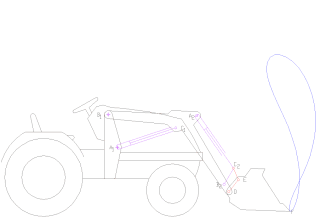
A loader is a heavy equipment machine used in construction to move or load materials such as soil, rock, sand, demolition debris, etc. into or onto another type of machinery.

A compactor is a machine or mechanism used to reduce the size of material such as waste material or bio mass through compaction. A trash compactor is often used by business and public places like hospitals to reduce the volume of trash they produce. A baler-wrapper compactor is often used for making compact and wrapped bales in order to improve logistics.

A dump truck, known also as a dumping truck, dump trailer, dumper trailer, dump lorry or dumper lorry or a dumper for short, is used for transporting materials for construction as well as coal. A typical dump truck is equipped with an open-box bed, which is hinged at the rear and equipped with hydraulic rams to lift the front, allowing the material in the bed to be deposited ("dumped") on the ground behind the truck at the site of delivery. In the UK, Australia, South Africa and India the term applies to off-road construction plants only and the road vehicle is known as a tip lorry, tipper lorry, tipper truck, tip truck, tip trailer or tipper trailer or simply a tipper.

A waste collector, also known as a garbageman, garbage collector, trashman, binman or dustman, is a person employed by a public or private enterprise to collect and dispose of municipal solid waste (refuse) and recyclables from residential, commercial, industrial or other collection sites for further processing and waste disposal. Specialised waste collection vehicles featuring an array of automated functions are often deployed to assist waste collectors in reducing collection and transport time and for protection from exposure. Waste and recycling pickup work is physically demanding and usually exposes workers to an occupational hazard.
Dempster Brothers, Inc. of Knoxville, Tennessee, was an industrial firm that made waste collection vehicles including the Dempster Dumpmaster and Dempster Dinosaur. The firm was originally established by George Roby Dempster with his brothers Thomas and John Dempster.

A skip (or skip bin) is a large open-topped waste container designed for loading onto a special type of lorry called a skip loader. Typically skip bins have a distinctive shape: the longitudinal cross-section of the skip bin is either a trapezium or two stacked trapezia. The lower trapezium has the smaller edge at the bottom of the skip bin, and a longer edge at the top. The smaller edge on either end is lower which makes it easier to load. Where there is an upper trapezium, it has the smaller edge at the top. There is a sloping floor or wall at each end. There are usually two lugs on each side of the bin onto which chains can be attached, permitting the heavy skip to be lifted onto and off a skip lorry or skip truck. A special skip-carrying lorry or crane is used.

Waste collection is a part of the process of waste management. It is the transfer of solid waste from the point of use and disposal to the point of treatment or landfill. Waste collection also includes the curbside collection of recyclable materials that technically are not waste, as part of a municipal landfill diversion program.

A waste container, also known as a dustbin, garbage can, and trash can, is a type of container that is usually made out of metal or plastic. The words "rubbish", "basket" and "bin" are more common in British English usage; "trash" and "can" are more common in American English usage. "Garbage" may refer to food waste specifically or to municipal solid waste in general.
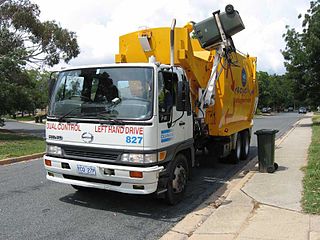
Kerbside collection or curbside collection is a service provided to households, typically in urban and suburban areas, of collecting and disposing of household waste and recyclables. It is usually accomplished by personnel using specially built vehicles to pick up household waste in containers that are acceptable to, or prescribed by, the municipality and are placed on the kerb.
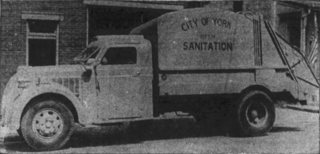
The Garwood Load Packer is an American waste collection vehicle that was built by Garwood Industries in Detroit, Michigan. Engineered by Melvin Donald Silvey, the Packer brought significant changes in the mode and automation of garbage collection in the United States.
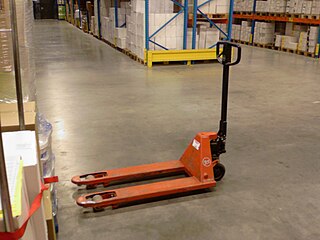
A pallet jack, also known as a pallet truck, pallet pump, pump truck, scooter, dog, or jigger is a tool used to lift and move pallets. Pallet jacks are the most basic form of a forklift and are intended to move pallets within a warehouse.
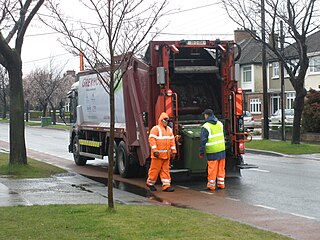
A green bin is a large, movable, rigid plastic or metal container that contains biodegradable waste or compostable materials as a means to divert waste from landfills. In some local authorities, green bins are also used to contain unsorted municipal solid waste.

The Miller Group is a diverse transportation construction company based in Markham, Ontario, Canada where its Corporate Head Office is located. Its U.S. headquarters is located in Morrow, Georgia.

Ground support equipment (GSE) is the support equipment found at an airport, usually on the apron, the servicing area by the terminal. This equipment is used to service the aircraft between flights. As the name suggests, ground support equipment is there to support the operations of aircraft whilst on the ground. The role of this equipment generally involves ground power operations, aircraft mobility, and cargo/passenger loading operations.

A dumpster is a movable waste container designed to be brought and taken away by a special collection vehicle, or to a bin that a specially designed garbage truck lifts, empties into its hopper, and lowers, on the spot. The word is a generic trademark of Dumpster, an American brand name for a specific design. Generic usage of skip, or wheelie bin may be used in other English speaking countries.

A grapple truck is a truck that has a grapple loader mounted to its frame which is used for loading and sometimes hauling bulky waste. A grapple loader is defined by ANSI Z245.1 as:
“a hydro-mechanical device able to rotate on an axis with a grapple or bucket attached at the end of the boom, which is intended for the collection of waste that due to size and/or weight is impractical to containerize.”

An aircraft lavatory or plane toilet is a small room on an aircraft with a toilet and sink. They are commonplace on passenger flights except some short-haul flights. Aircraft toilets were historically chemical toilets, but many now use a vacuum flush system instead.

In North America, a roll-off is a usually open-top dumpster characterized by a rectangular footprint, utilizing wheels to facilitate rolling the dumpster in place. The container is designed to be transported by special roll-off trucks. There are two types of delivery trucks for the bins based on bin size, and they are: Hook lift bins and Roll-off bins. Roll-offs are commonly used to contain loads of construction and demolition waste or other waste types. While most roll-off containers have a swinging door on the end for easier disposal of waste, some roll-off containers are not open-top and are used with commercial or industrial trash compactors.
References
- ↑ Simmons, Braden (1 December 2016). "Seven industrial problems solved by Simpro bin tippers - Simpro Blog". Archived from the original on 20 August 2017.
- ↑ "Bin Tippers From Solus Group On Display At WasteExpo Trade Show". solusgrp.com. Archived from the original on 2017-08-20.
- ↑ DMA Europa (29 April 2011). "What is the EN840 European Standard; why is it important". Archived from the original on 10 February 2018 – via YouTube.
- ↑ "Safe Carting". 1 April 2008. Archived from the original on 20 August 2017.
- ↑ Simmons, Braden (20 February 2017). "EN 840 vs ANSI Z245.60 - the bitter battle of the MGBs - Simpro Blog". Archived from the original on 20 August 2017.
- ↑ Sallmen, Joseph P. "Garbage Trucks - External Hoppers". www.tigerdude.com. Archived from the original on 2017-08-10. Retrieved 2017-08-15.
- ↑ Sallmen, Joseph P. "Garbage Trucks - Front End Loaders". www.tigerdude.com. Archived from the original on 2014-12-31. Retrieved 2017-08-15.
- ↑ Simmons, Braden (27 February 2012). "About Simpro - Smart lifting solutions since 1986 - Simpro". Simpro. Archived from the original on 2017-10-05.
- ↑ "OSH in figures: Work-related musculoskeletal disorders in the EU - Facts and figures | Safety and health at work EU-OSHA". Archived from the original on 2018-02-10. Retrieved 2017-10-04.
- ↑ Velasco Garrido, M; Bittner, C; Harth, V; Preisser, AM (2015). "Health status and health-related quality of life of municipal waste collection workers - a cross-sectional survey". J Occup Med Toxicol. 10: 22. doi: 10.1186/s12995-015-0065-6 . PMC 4493964 . PMID 26155300.
- ↑ "Archived copy" (PDF). Archived from the original (PDF) on 2016-07-05. Retrieved 2017-10-04.
{{cite web}}: CS1 maint: archived copy as title (link) - ↑ "Archived copy" (PDF). Archived (PDF) from the original on 2018-02-10. Retrieved 2017-10-04.
{{cite web}}: CS1 maint: archived copy as title (link) - ↑ "» Dumpmaster used to reduce manual handling Best Practice Hub". ccsbestpractice.org.uk. Archived from the original on 2017-08-20.